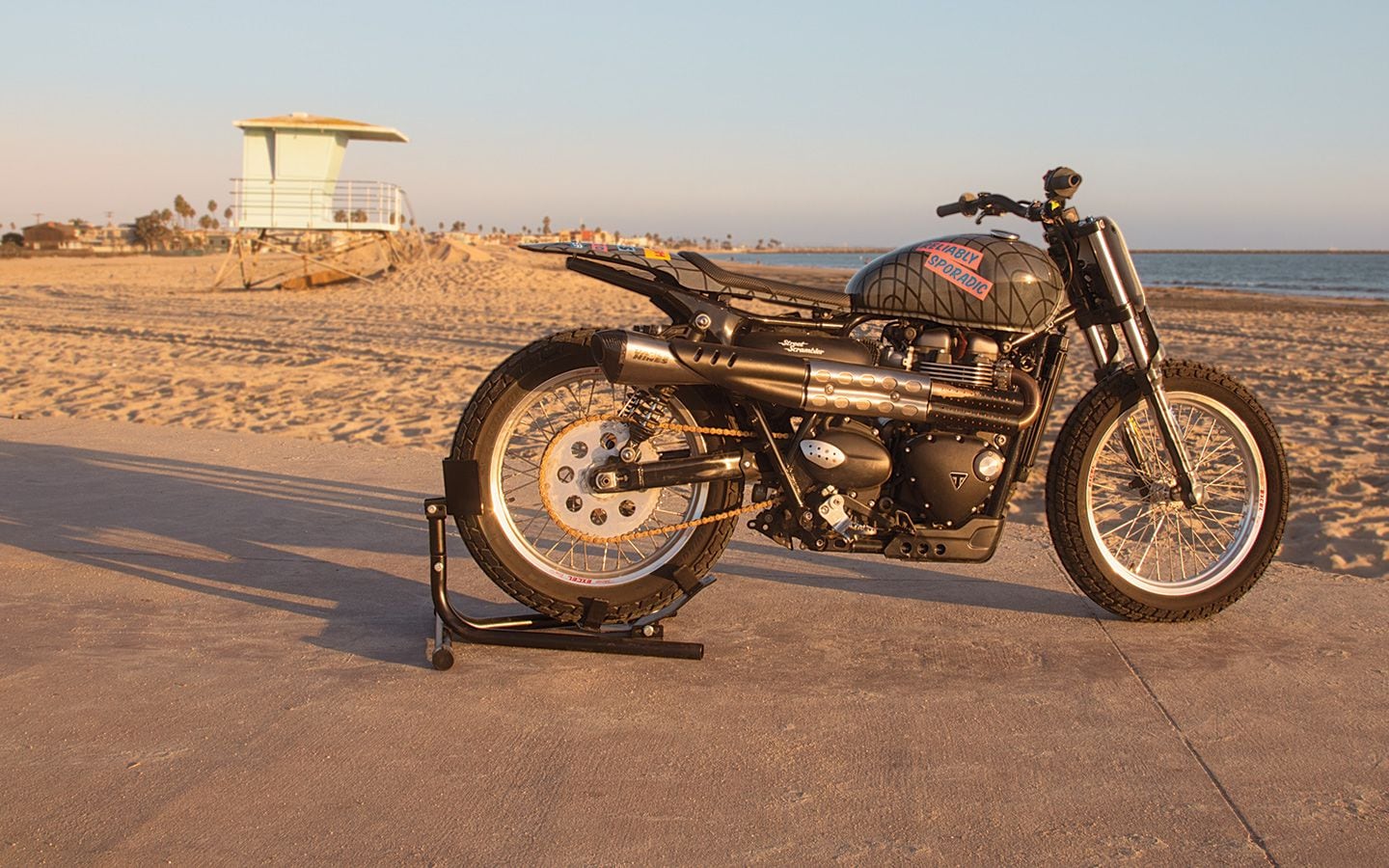Ripping anywhere and everywhere. That's what motorcycles like Triumph's Scrambler are all about. But instead of lining up at Starbucks, imagine yourself queuing up on the dirt in the Super Hooligan racing series. To demonstrate that the idea isn't too far-fetched, the folks at Deus Ex Machina teamed up with British American Motorcycles to tweak a new-generation Street Scrambler into a modern dirt tracker. The goal wasn't just to be competitive in the class, but also to compete with English panache. And the best part? They want you to have access to these hop-up parts so you can convert your Hinkley-made time machine into a dirt-roosting, sideways-spinning racer.
“Our plan was to keep it a little bit nostalgic,” says Deus Ex Machina's Julian Heppekausen, who splits his time between helping run the joint and spinning wrenches in the garage—when time allows, of course. “I’d rather be building bikes than building spreadsheets. The fact is you’re going to do a bit of both in this business,” he laughs.
This garage project began as many do: with a big splash of enthusiasm and some prodding from Triumph’s American subsidiary.
“We originally sketched some flat-track bikes before Triumph reached out to us,” Julian says. “The goal was to maintain that classic feel of old, sort-of-vintage flat-track bikes, but in a modern format.”
Deus leaned on its US motorcycle design director, Michael Woolaway, for the look of the tail. Woolie’s tidy, wafer-thin design replicates the appearance of dirt trackers from back in the day, including Gary Nixon’s championship-winning Trumpet machine from the late ’60s. It gives it a stance that means business when you arrive with the machine—it’s no longer street legal—in the back of a truck. A thin and nicely fabricated Saddlemen seat finishes things off.
“Woolie made it all out of polystyrene and foam,” Julian says of the tailpiece. “Then TaylorMade Racing laid it up and made a mold. We work with the guys over there quite a bit. They do amazing work. Paul [TaylorMade’s owner] is a really, really nice guy and has a lot of experience with carbon fiber.”
Experience is an understatement; the Los Angeles shop fabricated a prototype Moto2 chassis from the exotic material just for the heck of it.
“Paul is an innovator, and that’s the type of person we like working with. People who are willing to push things ahead and see what is possible.”
The Street Scrambler’s fuel tank has iconic style. The problem is it’s a tad bulky for racing. Deus wanted to slim the tank and fit something more agreeable for the rider as they push the bike down, searching for grip around turns. But Triumph was adamant about keeping the machine as stock as possible—including its signature tank.
“Triumph obviously wanted to keep a few things more stock than we would have liked on it,” Julian laughs.
Fortunately, the OE suspension wasn't one of those components. It was ditched for an original, non-inverted Yamaha YZF-R6 sportbike fork that operates through co-built triple clamps. This allows for flat-track-specific geometry, with full damping adjustment.
“The R6 fork is used a lot in flat track,” Julian says. “There’s a lot of tuners and suspension guys who know how to use it. Plus, it’s super-affordable. You could spend three grand or whatever on an Öhlins setup, but this piece works well.”
The top clamp also allows for alternative handlebar mounting. The Mika Metals handlebar was shifted closer to the rider, and the RC bend has a pleasing low and rearward sweep—providing just the right amount of leverage when you’re swinging loose off a turn.
The front end gives a good degree of bite with a natural steering feel. Out back is a pair of Fox shocks. The suspenders allow for damping as well as ride-height adjustment based on what the track is like that day or rider preference. It feels like this Scrambler was born for getting sideways.
Since final-drive gearing changes are a constant in dirt track racing, this Scrambler gets quick-change hardware from Banke Performance, easing maintenance chores for the mechanic. It wears 19-inch spoked wheels built by Dubya, and shod with Dunlop DT3 rubber.
Because traction is always limited, a good flat-track engine delivers smooth, big power. And when it comes to porting big twins, few do it better than renowned tuning shop Branch & O’Keefe. The SoCal shop went to work, carefully carving eight pounds of alloy from the cylinder head.
“Their philosophy is about just getting airflow through the motor,” Julian says. “We’ve gotten to the point where the heads are flowing so well that now the injectors and intake can’t keep up, so that will be our next level of development.”
On the back end, this Scrambler purges spent gases through a British Customs-sourced header paired with a Vance & Hines 2-into-1 muffler. It not only looks trick but also unleashes an even tastier growl.
Despite relying on the stock ECU, this parallel twin lays down smooth power with pleasing throttle response that’s neither too soft nor hard-hitting—an important characteristic of a hooked-up dirt tracker. We can only imagine how much better it will perform with the addition of a Power Commander and some quality dyno time. Custom fuel and ignition mapping will no doubt complement the engine’s more efficient airflow.
“It’s about making motorbikes rideable because you can have all the power in the world, but if you don’t feel safe on it, then you’ll never ride it to its ability,” he adds. “So really, what we concentrate on first is getting it actually rideable.”
This Deus-backed Triumph project proves the Street Scrambler is more than just a one-trick pony.












/cloudfront-us-east-1.images.arcpublishing.com/octane/SRBO3JKHTED2VIKDFDYUWVC5NI.jpg)
/cloudfront-us-east-1.images.arcpublishing.com/octane/ON3PHIYINEPHBD67LK6H7WABXU.jpg)
/cloudfront-us-east-1.images.arcpublishing.com/octane/SNRLWNBR7E6SYDCPMCHIKY3RVY.jpg)
/cloudfront-us-east-1.images.arcpublishing.com/octane/6PZCO3F7M4HVQB5DRAVT6KIO5A.jpg)
/cloudfront-us-east-1.images.arcpublishing.com/octane/56FMY6DANCIFV42GRMYI6RRGHU.jpg)
/cloudfront-us-east-1.images.arcpublishing.com/octane/MUQLOVLL2ZDGFH25ILABNBXKTI.jpg)
/cloudfront-us-east-1.images.arcpublishing.com/octane/TNOU5DNE2BC57MFPMGN2EIDXAM.jpg)
/cloudfront-us-east-1.images.arcpublishing.com/octane/GTCXACQGJ5HAPDTGWUQKDEH44E.jpg)
/cloudfront-us-east-1.images.arcpublishing.com/octane/S35YGSEMEZB4BLTDJTSZPF4GLA.jpg)
/cloudfront-us-east-1.images.arcpublishing.com/octane/5UOT6HPX2JFMRJAX6EH45AR4MQ.jpg)
/cloudfront-us-east-1.images.arcpublishing.com/octane/OKWOJWAKP5EP3OACCRRWPCIX2Q.jpg)
/cloudfront-us-east-1.images.arcpublishing.com/octane/2WF3SCE3NFBQXLDNJM7KMXA45E.jpg)
/cloudfront-us-east-1.images.arcpublishing.com/octane/G4MG6OUCJNBSHIS2MVVOTPX65E.jpg)
/cloudfront-us-east-1.images.arcpublishing.com/octane/IIGGWFOTOJGB7DB6DGBXCCMTDY.jpg)
/cloudfront-us-east-1.images.arcpublishing.com/octane/QSTCM6AVEZA5JJBUXNIQ3DSOF4.jpg)
/cloudfront-us-east-1.images.arcpublishing.com/octane/U4I7G625B5DMLF2DVIJDFZVV6M.jpg)
/cloudfront-us-east-1.images.arcpublishing.com/octane/B6XD6LS6IVCQPIU6HXDJSM3FHY.jpg)
/cloudfront-us-east-1.images.arcpublishing.com/octane/ICL63FEDDRDTTMINYICCEYGMDA.jpg)
/cloudfront-us-east-1.images.arcpublishing.com/octane/FCGZHQXRBZFLBAPC5SDIQLVF4I.jpg)
/cloudfront-us-east-1.images.arcpublishing.com/octane/WNOB6LDOIFFHJKPSVIWDYUGOPM.jpg)

/cloudfront-us-east-1.images.arcpublishing.com/octane/X33NU3E525ECRHXLNUJN2FTRKI.jpg)
/cloudfront-us-east-1.images.arcpublishing.com/octane/6KKT5NNL2JAVBOXMZYS5ZO76YA.jpg)
/cloudfront-us-east-1.images.arcpublishing.com/octane/J5RKG5O455GMPGQRF2OG6LRT7A.jpg)
/cloudfront-us-east-1.images.arcpublishing.com/octane/GX2CIZKQVRH2TATDM26KFG2DAE.jpg)
/cloudfront-us-east-1.images.arcpublishing.com/octane/ZWIDYSAKQZHD5BHREMQILXJCGM.jpg)
/cloudfront-us-east-1.images.arcpublishing.com/octane/CYUHJZCTSJCH3MRAQEIKXK7SCQ.jpg)
/cloudfront-us-east-1.images.arcpublishing.com/octane/LKOFINY56FCXJCANJ5M7ZDQUBY.jpg)
/cloudfront-us-east-1.images.arcpublishing.com/octane/4NBPDACMWJH63JQYJVK3QRBDZI.jpg)